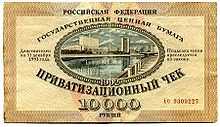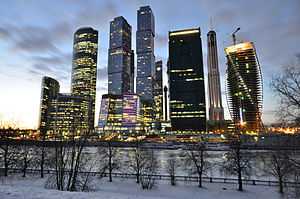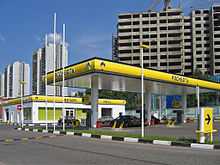Privatization in Russia
Russian privatization describes the series of reforms that resulted in the large-scale privatization of state-owned assets immediately after the collapse of the Soviet Union, most importantly in the industrial, energy, and financial sectors. The lion's share of privatization took place in Russia in the early and mid-1990s, during the presidency of Boris Yeltsin, who assumed the presidency immediately after the dissolution of the Soviet Union. Although Mikhail Gorbachev relaxed restrictions on private ownership in the mid to late 1980s, private ownership of enterprises and property had essentially been illegal throughout the Soviet era. Privatization enabled Russia to shift from the deteriorating Soviet planned economy towards a market economy, but, as a result, a good deal of the national wealth fell into the hands of a relatively small group of so-called business oligarchs (tycoons), and the wealth gap increased dramatically.[1] It was described as "Catastroika"[2] and as one of the "most cataclysmic peacetime economic collapse of an industrial country in history".[3] A few "strategic" assets, including much of the Russian military industry, were not privatized during the 1990s. The mass privatization of the 1990s remains a highly contentious issue in Russian society today, with many Russians calling for significant revisions or even a general reversal of the reforms. Indeed, many Russians view the privatization quite critically and hold strongly negative views towards its chief architects, notably Anatoly Chubais and Yegor Gaidar.
Spontaneous privatization (1988–1991)
Between 1988 and 1991, new Soviet legislation championed by Mikhail Gorbachev effectively transferred some controlling rights over enterprises from the government to the employees and management. The legislation also enabled these enterprises to withdraw from associations on their own, which led to the process of so-called spontaneous privatization in which control over some industrial assets was acquired by their managers. However, this accounted for only several thousand enterprises, a small fraction of the Soviet industry.[citation needed]
Voucher privatization (1992–1994)

Oil sector
Privatization of the oil sector was regulated by Presidential decree №1403 approved on November 17, 1992. Vertically integrated companies were created by joining some oil-producing enterprises and refineries into open-stock companies. Starting in 1994 many former state oil companies were privatized. This privatization has been partial because the federal government has obtained ownership positions in several companies and has also retained full control over the transport of oil onto lucrative world markets.[5]
Loans for shares (1995–1996)
In 1995, facing severe fiscal deficit and in desperate need of funds for the 1996 presidential elections, the government adopted a loans-for-share scheme proposed by banker Vladimir Potanin and endorsed by Anatoly Chubais, then a deputy prime minister, whereby some of the largest state industrial assets (including state-owned shares in Norilsk Nickel, YUKOS, LUKoil, Sibneft, Surgutneftegas, Novolipetsk Steel, Mechel) were leased through auctions for money lent by commercial banks to the government. The auctions, however, lacked competition, as they were largely controlled by favored insiders. As neither the loans nor the leased enterprises were returned in time, this effectively became a form of selling for a very low price. The scheme has been perceived by many as unfair, and it is the loans-for-shares scheme that gave rise to the class of Russian business oligarchs, who have concentrated enormous assets, further increasing the wealth gap in Russia and contributing to the political instability. Furthermore, in the medium-term, this scheme significantly hurt Russian growth since the oligarchs realized that their purchases could be seen as fraudulent by future governments and thus they attempted to strip assets from the government enterprises rather than build them up.
The first decade of the 2000s
From 2004 to 2006, the government took control of formally privatized companies in certain "strategic" sectors. oil, aviation, power generation equipment, machine-building and finance. For example, the state-owned defense equipment company Rosoboronexport took control of Avtovaz, the primary producer of Russian cars. In June 2006, it took 60% control of VSMPO-Avisma, a company that accounts for two-thirds of the world’s titanium production. In 2007, United Aircraft Building Corporation, a company that is 51% government controlled, combined all of the Russian companies producing aircraft.[6]
The 2010s
On December 2010 Russian President Dmitry Medvedev had ordered regional governments to decide on privatization of non-core assets by July 2011. Arkady Dvorkovich, then a top Kremlin economic aide, said regional privatization proceeds could amount to several billion rubles in 2011, and regional authorities must prioritize the sale of utility companies, financial institutions, manufacturing and transportation assets and the media.[7]
On May 2012, after becoming prime minister, Medvedev said Russia should carry out its privatization program regardless of market volatility.[8]
After a session of the World Economic Forum in October 2012, Medvedev said "It is vital for our country to continue the course towards privatization". He stressed that had assured participants in the World Economic Forum session that "does not want to see an economy totally controlled by the state".[9]
2011-2015 privatization plan
On October 2010 the Russian government has approved a plan to privatize a wide range of state property from energy to agriculture and banking to transportation.[10]
See also
- Economic history of the Russian Federation
- Banking in Russia
- History of post-Soviet Russia
- Business oligarch
References
- ↑ Holmstrom, Nancy; Richard Smith (February 2000). "The Necessity of Gangster Capitalism: Primitive Accumulation in Russia and China". Monthly Review (Monthly Review Foundation) 51 (09).
- ↑ "katastroika" definition from Double-Tongued Dictionary
- ↑ Milne, Seumas (16 August 2001). "Catastroika has not only been a disaster for Russia". The Guardian. Retrieved 17 September 2011.
- ↑ Hilary Appel, "Voucher Privatisation in Russia: Structural Consequences and Mass Response in the Second Period of Reform". Europe-Asia Studies, Vol. 49, No. 8 (Dec., 1997), pp. 1433–1449.
- ↑ Privatization with Government Control: Evidence from the Russian Oil Sector, Daniel Berkowitz and Yadviga Semikolenova
- ↑ Hanson, Philip. "The Russian Economic Puzzle: Going Forwards, Backwards, or Sideways?" International Affairs. 83(5), p. 876-877.
- ↑ "Medvedev orders regions to adopt privatization plans by July", RIA Novosti, December 7, 2010.
- ↑ "Medvedev: Privatizations Should Be Carried Out Regardless Of Mkt Volatility", Wall Street Journal, May 21, 2012.
- ↑ "Medvedev confirms course towards privatization of state property", ITAR-TASS, October 14, 2012
- ↑ "Russian government approves 5-year privatization plan", RIA Novosti, 21/10/2010.
Further reading
- Andrei Shleifer & Daniel Treisman, Without a Map: Political Tactics and Economic Reform in Russia. (Cambridge, MA: MIT Press, 2000). ISBN 0-262-19434-1
- Andrew Barnes. "What's the Difference? Industrial Privatisation and Agricultural Land Reform in Russia, 1990-1996". Europe-Asia Studies, Vol. 50, No. 5 (Jul., 1998), pp. 843–857.
- Chrystia Freeland, Sale of the Century: The Inside Story of the Second Russian Revolution (L.: Little Brown, 2000). ISBN 0-316-85360-7
- Hilary Appel, "Voucher Privatisation in Russia: Structural Consequences and Mass Response in the Second Period of Reform". Europe-Asia Studies, Vol. 49, No. 8 (Dec., 1997), pp. 1433–1449.
- Joseph R. Blasi, Maya Kroumova & Douglas Kruse, Kremlin Capitalism: Privatizing the Russian Economy (Ithaca, NY: ILR Press, 1997). ISBN 0-8014-8396-7
- Maxim Boycko, Andrei Shleifer & Robert Vishny, Privatizing Russia (Cambridge, MA – London: MIT Press, 1995). ISBN 0-262-02389-X
- Michael McFaul & Tova Perlmutter (eds.), Privatization, Conversion, and Enterprise Reform in Russia (Boulder, CO: Westview Press, 1995). ISBN 0-8133-3314-8
- Paul L. Joskow, Richard Schmalensee, Natalia Tsukanova & Andrei Shleifer. "Competition Policy in Russia during and after Privatization". Brookings Papers on Economic Activity. Microeconomics, Vol. 1994, (1994), pp. 301–381.
- Pekka Sutela, Insider Privatisation in Russia: Speculations on Systemic Change. Europe-Asia Studies, Vol. 46, No. 3 (1994), pp. 417–435.
- Roman Frydman, Andrzej Rapaczynski & John S. Earle, The Privatization Process in Russia, Ukraine and the Baltic States (Budapest: Central European University Press, 1993).
- Růžena Vintrová, "The general recession and the structural adaptation crisis", Eastern European Economics, Vol. 31, No. 3 (1993).
- Simon Johnson & Heidi Kroll, "Managerial Strategies for Spontaneous Privatization", Soviet Economy, Vol. 7, No. 4 (1991), pp. 281–316.
External links
| ||||||||||||||||||||||||||||||||||||||
| |||||||||||
| |||||||||||


